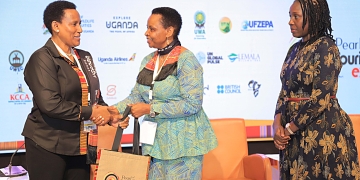
Conservationists working with Ugandan authorities are pushing for the rollout of digital technologies to bolster efforts in the general conservation of wildlife.
Dr. Chris Byaryomunsi, Uganda’s Minister for information and ICT told reporters early in the week that the move seeks help in tracing the movements of gorillas and other wildlife, along with monitoring all activities occurring in protected areas like national parks, game reserves, and Central Forest Reserves (CFCs).
He pointed out that during gorilla tracking, guides always rely on gorilla droppings and other traditional methods, which can sometimes prove challenging.
Baryomunsi adds that the basic techniques and strategies for preserving wildlife are no longer very effective or viable.
He made the remarks at the national conservation conference organised by the tourism ministry in collaboration with the World Wide Fund for Nature (WWF) Uganda, and the Uganda Wildlife Research and Training Institute at the Uganda Museum in Kampala.
The conference is part of the World Wildlife Day celebrations scheduled to take place on March 3, 2024.
This year’s celebrations will be held under the theme: Connecting People and the Planet; Exploring Digital Innovations for Wildlife Conservation.
“The last time I tracked gorillas, the guide was trying to track the droppings of gorillas. Using rudimentary methods trying to track is not effective, but we can use trackers to trace them and even monitor their habitats,” Baryomunsi said.
He emphasized the importance of integrating technology into every aspect of life, from wildlife conservation to tourism.
Baryomunsi said apart from keeping the tourists connected, technology also helps in the tracking of all illegal activities within the conservation areas.
“The poachers who kill animals, we can put tracking devices within the game parks or even tag these animals with devices, if they are moved or poached we can track their movement,” he added.
For effectiveness, Baryomunsi noted that the government is working on extending the national backbone infrastructure (optical fibre for internet) to the conservation areas.
“We are also extending masts such that we can have a telecom network in these areas among other innovations,” he added.
He observed their desire to incorporate technology as a central tool for managing wildlife conservation and effectively utilising natural resources.

Uganda Wildlife Authority (UWA) executive director Sam Mwandha said they have been able to find people in the parks and places where illicit operations are carried out by using technology.
He emphasized that in addition, they set up cameras to record events in real time.
“This helps us identify the wrong elements entering the national parks and we send our ranger to arrest them. These technologies have helped us preserve wildlife,” he said.
WWF Uganda forest restoration project manager Phillip Kihumuro highlighted the importance of using technology to safeguard habitats for wildlife and local communities near protected areas.
“Habitats are very important for wildlife, so we need to look and determine their losses in real-time using technology.
He emphasized that they are currently utilising technology to identify and track instances of deforestation and forest loss across various regions of the country.
“One of the approaches is using satellites and we usually do modelling to determine forest loss and this helps us to see where exactly we need to emphasize restoration. Currently, we are working on the Bugoma-Kagombe landscape in the Kagadi district. Before we do these restorations, we determine areas which have been degraded,” Kihumuroi added.
According to him, technology also assists them in identifying areas with dense human populations, enabling them to develop essential community engagement initiatives to promote coexistence with nature.
“We are fed by food from nature, we drink water from nature, and even our tourism is based on nature. The only way we can co-exist is by looking out for opportunities that we can harness from a growing population but also from nature itself,” Kihumuroi said.

Daniel Ndihiziwe, the manager for protected areas and conservation at the Worldwide Fund for Nature (WWF) noted the need to ensure the adoption of modern technology if Uganda is to achieve it conservation efforts
According to Ndihiziwe , the lack of coordination within civil society is one of the major issues that lead to the duplication of the technologies being used. “The transfer of game rangers by UWA also affects the entire system because there is a need to train the new ones who would be posted to the different protected areas,” Ndihiziwe adds.










